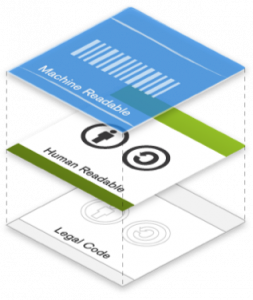The three layers of the CC licenses
The CC licenses were designed to be a free, voluntary solution for creators who want to grant the public up-front permissions to use their works. Although they are legally enforceable tools, they were designed in a way that was intended to make them accessible to non-lawyers.
The licenses are built using a three-layer design.

Image: “CC for Educators and Librarians is Available” by Creative Commons, used under CC BY 4.0 / Cropped from original.
- The legal code is the base layer. This contains the “lawyer-readable” terms and conditions that are legally enforceable in court.
- The human-readable (or commons deeds) layer is the most well-known layer of the licenses. These are the web pages that lay out the key license terms in so-called “human-readable” terms. The deeds are not legally enforceable but instead, summarize the legal code.
- The final layer of the license design recognizes that software plays a critical role in the creation, copying, discovery, and distribution of works. To make it easy for websites and web services to know when a work is available under a Creative Commons license, a “machine-readable” version of the license is available for embedding. When this metadata is embedded into CC licensed works, someone searching for a CC licensed work using a search engine (e.g., Google advanced search) can more easily discover CC licensed works.[1]
Test your knowledge
The three layers of the CC licenses © 2025 developed by William Perrenod is licensed under CC BY 4.0
